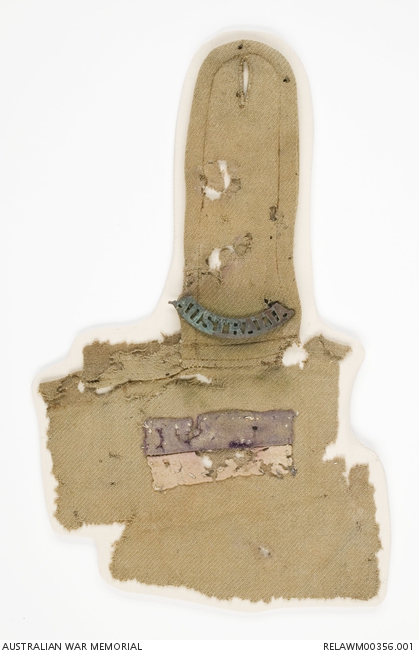| Places | |
|---|---|
| Accession Number | RELAWM00356.001 |
| Collection type | Heraldry |
| Object type | Heraldry |
| Physical description | Felt, Oxidised brass, Wool flannel, Wool twill |
| Location | Main Bld: First World War Gallery: The Anzac Story: Gallipoli: Fighting To The Stalemate |
| Maker |
Unknown |
| Place made | Australia |
| Date made | c 1914-1915 |
| Conflict |
First World War, 1914-1918 |
Shoulder strap and section of tunic with AUSTRALIA title and colour patch attached : 6 Battalion AIF, Krithia, Gallipoli



Khaki woollen shoulder strap and fragment of sleeve from an Australian service dress jacket. The fabric is ragged and faded, with numerous holes and tears. Just above the shoulder join of the strap is an oxidised brass 'AUSTRALIA' title, attached with a single brass split pin. At the top of the sleeve section is the remains of a horizontal purple over red colour patch, representing 6 Infantry Battalion, AIF. The patch has been crudely sewn on to the uniform with white thread. The upper (purple) section of the patch is made of wool flannel, and while soiled, retains much of its original colour. The lower (red) section appears to be made of felted wool, and has faded almost entirely to a very pale pink khaki.
Relic of the advance towards Krithia made by the 2nd AIF Brigade (5, 6, 7 and 8 Infantry Battalions) on the afternoon of 8 May 1915. Some 500 Australians were killed in this attack, and many of their bodies, being under direct enemy fire, could not be recovered.
Charles Bean and the Australian Historical Mission returned to Gallipoli in early 1919, and visited the Krithia battlefield on 8 March, looking for signs of the Australian soldiers. In his book 'Gallipoli Mission' (1948), Bean wrote that they 'found the remains of Australians everywhere on the plain, as far forward as the two trenches of the Redoubt Line, 400 and 500 yards ahead respectively. We found Australian kit, and the arm patches of the 6th Battalion, red and purple, and the bronze "Australia" from the shoulder strap, right up to the front Redoubt Line.'
A number of these poignant items were collected by the Historical Mission, while the bodies were buried, mostly in Redoubt Cemetery, by the Imperial War Graves Commission.